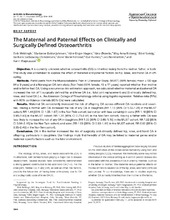| dc.contributor.author | Weldingh, Eirik | en_US |
| dc.contributor.author | Johnsen, Marianne Bakke | en_US |
| dc.contributor.author | Hagen, Kåre Birger | en_US |
| dc.contributor.author | Østerås, Nina | en_US |
| dc.contributor.author | Risberg, May Arna | en_US |
| dc.contributor.author | Natvig, Bård | en_US |
| dc.contributor.author | Christensen, Barbara Therese Slatkovsky | en_US |
| dc.contributor.author | Fenstad, Anne Marie | en_US |
| dc.contributor.author | Furnes, Ove | en_US |
| dc.contributor.author | Nordsletten, Lars | en_US |
| dc.contributor.author | Magnusson, Karin | en_US |
| dc.date.accessioned | 2020-05-11T07:14:38Z | |
| dc.date.available | 2020-05-11T07:14:38Z | |
| dc.date.issued | 2019-11 | |
| dc.Published | Weldingh, Johnsen MB, Hagen KB, Østerås N, Risberg MA, Natvig BN, Christensen BT, Fenstad F, Furnes O, Nordsletten L, Magnusson K. The Maternal and Paternal Effects on Clinically and Surgically Defined Osteoarthritis. Arthritis & Rheumatology. 2019;71(11):1844-1848 | eng |
| dc.identifier.issn | 2326-5191 | |
| dc.identifier.issn | 2326-5205 | |
| dc.identifier.uri | https://hdl.handle.net/1956/22166 | |
| dc.description.abstract | Objective: It is currently unknown whether osteoarthritis (OA) is inherited mainly from the mother, father, or both. This study was undertaken to explore the effect of maternal and paternal factors on hip, knee, and hand OA in offspring. Methods: Participants from the Musculoskeletal Pain in Ullensaker Study (MUST) (69% female; mean ± SD age 64 ± 9 years) and a Norwegian OA twin study (Nor‐Twin) (56% female; 49 ± 11 years) reported whether their mother and/or father had OA. Using a recurrence risk estimation approach, we calculated whether maternal and paternal OA increased the risk of 1) surgically defined hip and knee OA (i.e., total joint replacement) and 2) clinically defined hip, knee, and hand OA (i.e., the American College of Rheumatology criteria) using logistic regression. Relative risks (RRs) with 95% confidence intervals (95% CIs) were calculated. Results: Maternal OA consistently increased the risk of offspring OA across different OA locations and severities. Having a mother with OA increased the risk of any OA in daughters (RR 1.13 [95% CI 1.02–1.25] in the MUST cohort; RR 1.44 [95% CI 1.05–1.97] in the Nor‐Twin cohort) but not (or with less certainty) in sons (RR 1.16 [95% CI 0.95–1.43] in the MUST cohort; RR 1.31 [95% CI 0.71–2.41] in the Nor‐Twin cohort). Having a father with OA was less likely to increase the risk of any OA in daughters (RR 1.00 [95% CI 0.85–1.16] in the MUST cohort; RR 1.52 [95% CI 0.94–2.46] in the Nor‐Twin cohort) and sons (RR 1.08 [95% CI 0.83–1.41] in the MUST cohort; RR 0.93 [95% CI 0.35–2.48] in the Nor‐Twin cohort). Conclusion: OA in the mother increased the risk of surgically and clinically defined hip, knee, and hand OA in offspring, particularly in daughters. Our findings imply that heredity of OA may be linked to maternal genes and/or maternal‐specific factors such as the fetal environment. | en_US |
| dc.language.iso | eng | eng |
| dc.publisher | Wiley | eng |
| dc.rights | Attribution-NonCommercial CC BY-NC | eng |
| dc.rights.uri | http://creativecommons.org/licenses/by-nc/4.0/ | eng |
| dc.title | The Maternal and Paternal Effects on Clinically and Surgically Defined Osteoarthritis | en_US |
| dc.type | Peer reviewed | |
| dc.type | Journal article | |
| dc.date.updated | 2020-01-23T10:43:17Z | |
| dc.description.version | publishedVersion | en_US |
| dc.rights.holder | Copyright 2019 The Author(s) | |
| dc.identifier.doi | https://doi.org/10.1002/art.41023 | |
| dc.identifier.cristin | 1755993 | |
| dc.source.journal | Arthritis & Rheumatology | |

